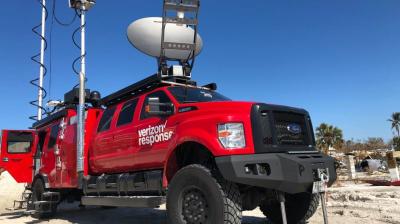- Verizon often deploys its mobile rapid response command center vehicle, THOR, when disasters strike
- THOR’s not at the scene in Southern California
- Verizon says it can deliver the goods with less flashy assets
Sometimes, less is better. That applies to the assets Verizon brought to the Los Angeles area during the devastating wildfires these past couple weeks.
Verizon often deploys its Tactical Humanitarian Operations Response vehicle, somewhat affectionately known as THOR, when reacting to disasters like hurricanes and wildfires. But not so in LA.

“THOR’s not needed because the assets we have in place are doing a fantastic job,” said Cory Davis, VP at Verizon Frontline. “What we’re trying to do is actually shrink our footprint, so we’re not disrupting what’s coming in,” such as assistance from the Federal Emergency Management Agency (FEMA).
Given that fire trucks had trouble getting around after people fled for their lives – leaving stranded vehicles that had to be removed with bulldozers – Verizon decided to leave THOR at a site in Texas where other large deployable assets are being staged.
“Everybody’s coming in with big assets, so our goal is to reduce that footprint and cause less disruption in the response as we can,” Davis told Fierce.
Verizon brought plenty of smaller assets to the scene, including portable generators and temporary cell sites.
The cell sites are temporary until Verizon and others can rebuild with permanent infrastructure. Ericsson is the dominant wireless infrastructure vendor in the LA market. Verizon and T-Mobile both use Ericsson in LA. AT&T is swapping out equipment across the U.S. after deciding in 2023 to go with Ericsson’s open Radio Access Network (RAN) technology and to remove Nokia, a process that is now underway and expected to be complete in 2026.
Minimal disruption
Like other operators, Verizon was aware of the forecast for the Santa Ana winds and started sending generators and other gear to Southern California several days before all hell broke out around January 6.
All of the major U.S. carriers were able to get their networks back up fairly quickly. An Ookla analysis of Speedtest Intelligence data shows there was a steep decline in network performance on January 8, but by January 12, wireless networks in the LA area were operating at nearly the same level they were prior to January 6.

Some areas are still inaccessible for safety reasons, but Verizon by early last week had restored more than 90% of the macro cell sites that were affected by the wildfires, windstorms and public safety power shut offs, said Findlay Faubion, senior director of Network Performance at Verizon.
Faubion didn’t disclose how many cell sites or towers were destroyed. But he alluded to some creative solutions that Verizon’s engineers devised on the fly. For example, at one beachside park command center, they discovered a macro site down the street that was still in service. Then they used (the rather rare) Verizon-owned aerial fiber to connect to a Cell on Light Truck (COLT) equipped with C-band spectrum to provide coverage in that area.
He and his team are constantly plotting where to prioritize their assets. “It’s finding the right solution for that situation. Sometimes you need a microwave link, sometimes satellite backhaul is your best option,” he said.
Many people might be aware that T-Mobile switched on its direct-to-device satellite emergency alert service via its Starlink partnership during the wildfires. Verizon also offers a satellite-based D2D service, which is in addition to Apple’s Emergency SOS for iPhone uses. Customers with select Android devices are able to send emergency text messages via Verizon’s Skylo deal.
As anyone can imagine, the work takes a toll. But Davis said the Frontline team prepares for worst-case scenarios every day. And while Verizon employees are working around the clock, they’re there to support firefighters and other first responders on the ground.
“It’s just been a heroic response from everybody,” Davis said. “They are truly putting their lives at risk, and they are doing a phenomenal job.”